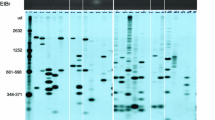Abstract
The polymerase chain reaction was evaluated for its ability to amplify DNA sequences specific for the root-knot nematode Meloidogyne hapla, using oligonucleotides whose sequence was deduced from the satellite DNA previously cloned in this species as primers. As expected, ladder patterns of monomers and multimers of an approximate 150–170-bp repeat were amplified from purified genomic DNA of all the M. hapla isolates studied, while no amplification was detected with the five other Meloidogyne species tested. Moreover, the satellite DNA nature of the amplification products was confirmed through Southern-blot hybridization with the previously cloned monomeric unit. In further experiments, DNA was extracted from single females, males, juveniles, or eggs according to a simple procedure, and used as a template in PCR assays. Amplification products were obtained, whose electrophoretic patterns were always very similar to those from M. hapla genomic DNA, thus demonstrating the high sensitivity of the method. This satellite DNA-based strategy can be exploited to develop species-specific primer sets for use on a routine basis as a diagnostic tool for unambiguous nematode identification procedures.
Similar content being viewed by others
References
Bachmann L, Schibel JM, Raab M, Sperlich D (1993) Satellite DNA as a taxonomic marker. Biochem Syst Ecol 21:3–11
Baum TJ, Gresshoff PM, Lewis SA, Dean RA (1994) Characterization and phylogenetic analysis of four root-knot nematode species using DNA amplification fingerprinting and automated polyacrylamide gel electrophoresis. Mol Plant-Microbe Interact 7:39–47
Brutlag DL (1980) Molecular arrangement and evolution of heterochromatic DNA. Annu Rev Genet 14:121–144
Carpenter AS, Hiatt EE, Lewis SA, Abbott AG (1992) Genomic RFLP analysis of Meloidogyne arenaria race 2 populations. J Nematol 24:23–28
Castagnone-Sereno P, Piotte C, Abad P, Bongiovanni M, Dalmasso A (1991) Isolation of a repeated DNA probe showing polymorphism between Meloidogyne incognita populations. J Nematol 23:316–320
Castagnone-Sereno P, Vanlerberghe-Masutti F, Leroy F (1994) Genetic polymorphism between and within Meloidogyne species detected with RAPD markers. Genome 37:904–909
Cenis JL (1993) Identification of four major Meloidogyne spp. by random amplified polymorphic DNA (RAPD-PCR). Phytopathology 83:76–80
Chacon MR, Rodriguez E, RME Parkhouse, Burrows PR, Garate T (1994) The differentiation of parasitic nematodes using random amplified polymorphic DNA. J Helminthol 68:109–113
Dalmasso A, Bergé JB (1978) Molecular polymorphism and phylogenetic relationship in some Meloidogyne spp.: application to the taxonomy of Meloidogyne. J Nematol 10:323–332
Feinberg AP, Vogelstein B (1983) A technique for radiolabeling DNA restriction endonuclease fragments to high specific activity. Anal Biochem 112:295–298
Ferris H, Carlson HR, Viglierchio DR, Westerdahl BB, Wu FW, Anderson CE, Juurma A, Kirby DW (1993) Host status of selected crops to Meloidogyne chitwoodi. J Nematol 25:849–857
Garate T, Robinson MP, Chacon MR, Parkhouse RME (1991) Characterization of species and races of the genus Meloidogyne by DNA restriction enzyme analysis. J Nematol 23:414–420
Henson JM, French R (1993) The polymerase chain reaction and plant disease diagnosis. Annu Rev Phytopathol 31:81–109
John B, Miklos GLG (1979) Functional aspects of satellite DNA and heterochromatin. Int Rev Cytol 58:1–114
Meredith SEO, Lando G, Gbakima AA, Zimmerman PA, Unnasch TR (1991) Onchocerca volvulus: application of the polymerase chain reaction to identification and strain differentiation of the parasite. Exp Parasitol 73:335–344
Piotte C, Castagnone-Sereno P, Uijthof J, Abad P, Bongiovanni M, Dalmasso A (1992) Molecular characterization of species and populations of Meloidogyne from various geographic origins with repeated DNA-homologous probes. Fundam Appl Nematol 15:271–276
Piotte C, Castagnone-Sereno P, Bongiovanni M, Dalmasso A, Abad P (1994) Cloning and characterization of two satellite DNAs in the low-C-value genome of the nematode Meloidogyne spp. Gene 138:175–180
Piotte C, Castagnone-Sereno P, Bongiovanni M, Dalmasso A, Abad P (1995) Analysis of a satellite DNA from M. hapla and its use as a diagnostic probe. Phytopathology 85:458–462
Powers TO, Harris TS (1993) A polymerase chain reaction method for the identification of five major Meloidogyne species. J Nematol 25:1–6
Powers TO, Platzer EG, Hyman BC (1986) Species-specific restriction site polymorphism in root-knot nematode mitochondrial DNA. J Nematol 18:288–293
Sambrook J, Fritsch EF, Maniatis T (1989) Molecular cloning: a laboratory manual, 2nd edn. Cold Spring Harbor Laboratory, Cold Spring Harbor, New York
Sasser JN, Carter CC (1985) Overview of the International Meloidogyne Project 1975–1984. In: Sasser JN, Carter CC (eds) An advanced treatise on Meloidogyne, vol II. Biology and control. North Carolina State University Graphics, Raleigh, pp 19–24
Smith GE, Summers MD (1980) The bidirectional transfer of DNA and RNA to nitrocellulose or diazobenzylomethyl-paper. Anal Biochem 109:123–129
Tarès S, Lemontey JM, De Guiran G, Abad P (1994) Use of a species-specific satellite DNA from Bursaphelenchus xylophilus as a diagnostic probe. Phytopathology 84:294–298
Author information
Authors and Affiliations
Additional information
Communicated by P. J. G. M. de Wit
Rights and permissions
About this article
Cite this article
Castagnone-Sereno, P., Esparrago, G., Abad, P. et al. Satellite DNA as a target for PCR-specific detection of the plant-parasitic nematode Meloidogyne hapla . Curr Genet 28, 566–570 (1995). https://doi.org/10.1007/BF00518170
Received:
Issue Date:
DOI: https://doi.org/10.1007/BF00518170




